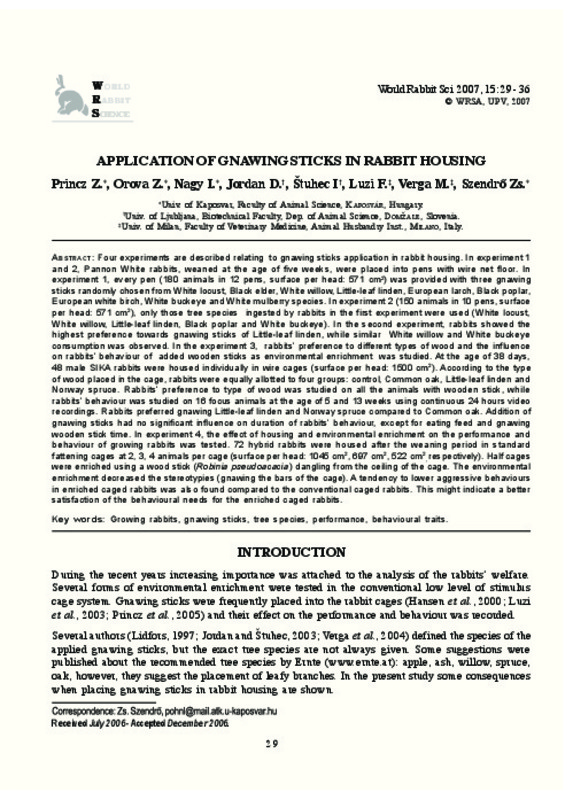|
Resumen:
|
[EN] Four experiments are described relating to gnawing sticks application in rabbit housing. In experiment 1 and 2, Pannon White rabbits, weaned at the age of five weeks, were placed into pens with wire net floor. In ...[+]
[EN] Four experiments are described relating to gnawing sticks application in rabbit housing. In experiment 1 and 2, Pannon White rabbits, weaned at the age of five weeks, were placed into pens with wire net floor. In experiment 1, every pen (180 animals in 12 pens, surface per head: 571 cm2) was provided with three gnawing sticks randomly chosen from White locust, Black elder, White willow, Little-leaf linden, European larch, Black poplar, European white birch, White buckeye and White mulberry species. In experiment 2 (150 animals in 10 pens, surface per head: 571 cm2), only those tree species ingested by rabbits in the first experiment were used (White locust, White willow, Little-leaf linden, Black poplar and White buckeye). In the second experiment, rabbits showed the highest preference towards gnawing sticks of Little-leaf linden, while similar White willow and White buckeye consumption was observed. In the experiment 3, rabbits¿ preference to different types of wood and the influence on rabbits¿ behaviour of added wooden sticks as environmental enrichment was studied. At the age of 38 days, 48 male SIKA rabbits were housed individually in wire cages (surface per head: 1500 cm2). According to the type of wood placed in the cage, rabbits were equally allotted to four groups: control, Common oak, Little-leaf linden and Norway spruce. Rabbits¿ preference to type of wood was studied on all the animals with wooden stick, while rabbits¿ behaviour was studied on 16 focus animals at the age of 5 and 13 weeks using continuous 24 hours video recordings. Rabbits preferred gnawing Little-leaf linden and Norway spruce compared to Common oak. Addition of gnawing sticks had no significant influence on duration of rabbits¿ behaviour, except for eating feed and gnawing wooden stick time. In experiment 4, the effect of housing and environmental enrichment on the performance and behaviour of growing rabbits was tested. 72 hybrid rabbits were housed after the weaning period in standard fattening cages at 2, 3, 4 animals per cage (surface per head: 1045 cm2, 697 cm2, 522 cm2, respectively). Half cages were enriched using a wood stick (Robinia pseudoacacia) dangling from the ceiling of the cage. The environmental enrichment decreased the stereotypies (gnawing the bars of the cage). A tendency to lower aggressive behaviours in enriched caged rabbits was also found compared to the conventional caged rabbits. This might indicate a better satisfaction of the behavioural needs for the enriched caged rabbits.
[-]
|








